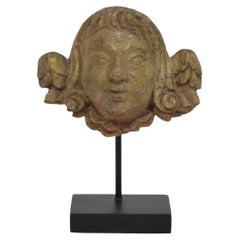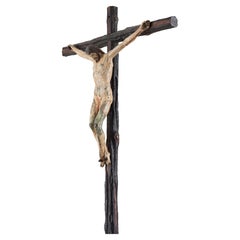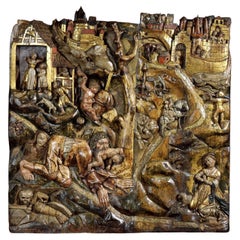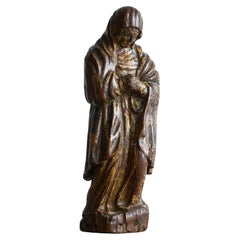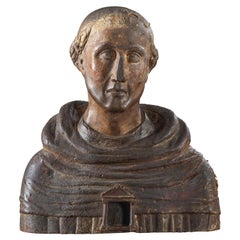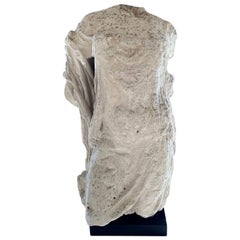16th Century Figurative Sculptures
to
17
103
1,143
3,745
9,141
2,677
2,286
3,251
2,054
302
160
560
565
258
525
576
669
400
262
4
1
66
22
13
13
12
72
29
68
25
21
14
13
Height
to
Width
to
103
103
103
1
Period: 16th Century
French 16th/ 17th Century Weathered Oak Renaissance Angel Fragment
Located in Buisson, FR
Beautiful weathered oak winged angel head Renaissance ornament.
France, 16/ 17th century. Weathered
Measurements include the wooden pedestal.
Category
French Renaissance Antique 16th Century Figurative Sculptures
Materials
Oak
$266 Sale Price
47% Off
Rare and important painted bronze Crucifix after a model by Michelangelo
By Michelangelo Buonarroti
Located in Leesburg, VA
A rare and very fine bronze corpus of Christ after a model by Michelangelo, cast ca. 1597-1600 by Juan Bautista Franconio and painted in 1600 by Francisco Pacheco in Seville, Spain.
The present corpus reproduces a model attributed to Michelangelo. The best known example, lesser in quality, is one on display at the Metropolitan Museum of Art (MET).
The association of this corpus with Michelangelo was first brought to light by Manuel Gomez-Moreno (1930-33) who studied the wider circulated casts identified throughout Spain. The attribution to Michelangelo was subsequently followed by John Goldsmith-Phillips (1937) of the MET and again by Michelangelo expert, Charles de Tolnay (1960).
While Michelangelo is best known for his monumental works, there are four documented crucifixes he made. The best known example is the large-scale wooden crucifix for the Church of Santa Maria del Santo Spirito in Florence, made in 1492 as a gift for the Prior, Giovanni di Lap Bicchiellini, for allowing him to study the anatomy of corpses at the hospital there. In 1562, Michelangelo wrote two letters to his nephew, Lionardo, indicating his intention to carve a wooden crucifix for him. In 1563 a letter between Lionardo and the Italian sculptor Tiberio Calcagni, mentions this same crucifix (a sketch of a corpus on the verso of a sheet depicting Michelangelo’s designs for St. Peter’s Basillica [Palais des Beaux-Arts in Lille] may reproduce this). That Michelangelo was working on small corpora in the last years of his life is further evidenced by the small (26.5 cm) unfinished wooden crucifix located at the Casa Buonarroti, considered his last known sculptural undertaking. Michelangelo’s contemporary biographer, Giorgio Vasari additionally cites that Michelangelo, in his later years, made a small crucifix for his friend, Menighella, as a gift.
Surviving sketches also indicate Michelangelo’s study of this subject throughout his career, most notably during the end of his life but also during the 1530s-40s as he deepened his spiritual roots. The occasional cameo of crucified Christ’s throughout his sketched oeuvre have made it challenging for scholars to link such sketches to any documented commissions of importance. All the while, in consideration that such objects were made as gifts, it is unlikely they should be linked with commissions.
Nonetheless, a number of theories concerning Michelangelo’s sketches of Christ crucified have been proposed and some may regard the origin of the present sculpture. It has been suggested that the corpus could have its impetus with Michelangelo’s work on the Medici Chapel, whose exclusive design was given to the master. It is sensible smaller details, like an altar cross, could have fallen under his responsibility (see for example British Museum, Inv. 1859,0625.552). Others have noted the possibility of an unrealized large marble Crucifixion group which never came to fruition but whose marble blocks had been measured according to a sheet at the Casa Buonarroti.
A unique suggestion is that Michelangelo could have made the crucifix for Vittoria Colonna, of whom he was exceedingly fond and with whom he exchanged gifts along with mutual spiritual proclivities. In particular, Vittoria had an interest in the life of St. Bridget, whose vision of Christ closely resembles our sculpture, most notably with Christ’s proper-left leg and foot crossed over his right, an iconography that is incredibly scarce for crucifixes. The suggestion could add sense to Benedetto Varchi’s comment that Michelangelo made a sculpted “nude Christ…he gave to the most divine Marchesa of Pescara (Vittoria Colonna).”
Of that same period, two sketches can be visually linked to our sculpture. Tolnay relates it to a sketch of a Crucified Christ at the Teylers Museum (Inv. A034) of which Paul Joannides comments on its quality as suggestive of preparations for a sculptural work. Joannides also calls attention to a related drawing attributed to Raffaello da Montelupo copying what is believed to be a lost sketch by Michelangelo. Its relationship with our sculpture is apparent. Montelupo, a pupil of Michelangelo’s, returned to Rome to serve him in 1541, assisting with the continued work on the tomb of Pope Julius II, suggesting again an origin for the corpus ca. 1540.
The earliest firm date that can be given to the present corpus is 1574 where it appears as a rather crudely conceived Crucifixion panel, flanked by two mourners in low-relief and integrally cast for use as the bronze tabernacle door to a ciborium now located at the Church of San Lorenzo in Padula. Etched in wax residue on the back of the door is the date, 27 January 1574, indicating the corpus would have at least been available as a model by late 1573.
The Padula tabernacle was completed by Michelangelo’s assistant, Jacopo del Duca and likely has its origins with Michelangelo’s uncompleted tabernacle for the Basilica of St. Mary of the Angels in Rome.
The impetus for the Padula tabernacle’s Crucifixion panel begins with a series of late Crucifixion sketches by Michelangelo, depicting a scene of Christ crucified and flanked by two mourners (see British Museum Inv. 1895.0915.510; Ashmolean Museum Inv. 1846.89, KP II 343 recto; Windsor Castle RCIN 912761 recto; and Louvre Inv. 700). A faintly traced block possibly intended for sculpting the sketch of the crucified Christ on its recto was discovered by Tolnay on a version of the composition at Windsor Castle. The Windsor sketch and those related to it appear to have served as preparatory designs for what was probably intended to become the Basilica of St. Mary’s tabernacle door. Vasari documents that the project was to be designed by Michelangelo and cast by his assistant, Jacopo del Duca. Michelangelo died before the commission was complete, though on 15 March 1565, Jacopo writes to Michelangelo’s nephew stating, “I have started making the bronze tabernacle, depending on the model of his that was in Rome, already almost half complete.” Various circumstances interrupted the completion of the tabernacle, though its concept is later revitalized by Jacopo during preparations to sell a tabernacle, after Michelangelo’s designs, to Spain for Madrid’s El Escorial almost a decade later. The El Escorial tabernacle likewise encountered problems and was aborted but Jacopo successfully sold it shortly thereafter to the Carthusians of Padula.
An etched date, 30 May 1572, along the base of the Padula tabernacle indicates its framework was already cast by then. A 1573 summary of the tabernacle also describes the original format for the door and relief panels, intended to be square in dimension. However, a last minute decision to heighten them was abruptly made during Jacopo’s negotiations to sell the tabernacle to King Phillip II of Spain. Shortly thereafter the commission was aborted. Philippe Malgouyres notes that the Padula tabernacle’s final state is a mixed product of the original design intended for Spain’s El Escorial, recycling various parts that had already been cast and adding new quickly finished elements for its sale to Padula, explaining its unusually discordant quality, particularly as concerns the crudeness of the door and relief panels which were clearly made later (by January 1574).
Apart from his own admission in letters to Spain, it is apparent, however, that Jacopo relied upon his deceased master’s designs while hastily realizing the Padula panels. If Michelangelo had already earlier conceived a crucifix model, and Jacopo had access to that model, its logical he could have hastily employed it for incorporation on the door panel to the tabernacle. It is worth noting some modifications he made to the model, extending Christ’s arms further up in order to fit them into the scale of the panel and further lowering his chin to his chest in order to instill physiognomic congruence. A crude panel of the Deposition also follows after Michelangelo’s late sketches and is likewise known by examples thought to be modifications by Jacopo based upon Michelangelo’s initial sculptural conception (see Malgouyres: La Deposition du Christ de Jacopo del Duca, chef-d’oeuvre posthume de Michel-Ange).
Jacopo’s appropriation of an original model by Michelangelo for more than one relief on the Padula tabernacle adds further indication that the crucifix was not an object unique to Jacopo’s hand, as few scholars have posited, but rather belongs to Michelangelo’s original...
Category
Renaissance Antique 16th Century Figurative Sculptures
Materials
Bronze
Wood Low-Relief Depicting a Werewolf and Saint George
Located in Saint-Ouen, FR
Exceptional polychrome wood low-relief depicting a werewolf and saint george after a woodcut by lucas cranach (“DER WERWOLF” 1512)
Provenance :
collection Brimo de Laroussihle
colle...
Category
German Renaissance Antique 16th Century Figurative Sculptures
Materials
Wood
16th Century Mary Magdalene in Polychromed Carved Walnut
Located in Meer, VAN
Mary Magdalene in Polychromed Carved Walnut 16th Century
Devotional figure in carved wood, depicting Mary Magdalene. Walnut, most probably Flemish and from the 16th century.
It de...
Category
European Medieval Antique 16th Century Figurative Sculptures
Materials
Walnut
16th Century Polychrome Reliquary of a Monk
Located in Saint-Ouen, FR
The monk is depicted with an oval face, marked with high and strong cheekbones, sunken cheeks, strong jawbones and a cleft chin. His almond shaped eyes are opened under very strong a...
Category
Italian Renaissance Antique 16th Century Figurative Sculptures
Materials
Wood
16th Century Stone Classical Roman Style Torso
Located in Vosselaar, BE
A wonderful 16th century draped female torso in classical style. Made in France under Italian Renaissance influence this female torso is finely sculpted with great detail to the stol...
Category
French Renaissance Antique 16th Century Figurative Sculptures
Materials
Sandstone
An Unusual and Rare English ‘Memento Mori’ Carved Shrine with Two Human Skulls
Located in London, GB
An Unusual and Rare English ‘Memento Mori’ Carved Shrine with Two Human Skulls to the underside, a carved ‘Dragonfly’
Marble
16th / 17th Century
England
Size: 36cm high, 28cm w...
Category
English Antique 16th Century Figurative Sculptures
Materials
Marble
Paolo di Giovanni Sogliani - Processional Cross Florence, around 1515
Located in Bruxelles, BE
Paolo di Giovanni Sogliani (Florence 1455-1522)
Processional Cross
Florence, around 1515
Enameled, chiseled, engraved, stippled, and gilded copper; wooden core ; Inscription: "OPA...
Category
Italian Renaissance Antique 16th Century Figurative Sculptures
Materials
Copper, Enamel
Pair Ming Dynasty Glazed Pottery Dignitary Figures
Located in Dallas, TX
A pair of Ming dynasty sancai blue glazed pottery figures.
Circa 1500 AD Ming Dynasty
I have owned over 250 ming tomb figures including over 80...
Category
Chinese Ming Antique 16th Century Figurative Sculptures
Materials
Pottery
Christ Crucified in Silver 16th Century Italian School
Located in Madrid, ES
Christ crucified in silver
16th Century Italian school
Measure: height: 40cm.
very good condition.
Category
Italian Baroque Antique 16th Century Figurative Sculptures
Materials
Silver
16th Century Southern Germany Carved Wood Bracket Depicting a Mermaid
Located in Saint-Ouen, FR
In Medieval Europe and even more during the early 16th century fantastic beasts could be found in Bestiaries, a literary genre close to poetry. A bestiary used the characteristics of...
Category
German Renaissance Antique 16th Century Figurative Sculptures
Materials
Wood
Japanese Giltwood Medicine Buddha, Yakushi Nyorai, Muromachi Period 16th Century
Located in Austin, TX
A striking Japanese late Muromachi Period (1333-1573) lacquered and giltwood figure of Yakushi Nyorai, the Medicine Buddha, seated upon an elaborate car...
Category
Japanese Edo Antique 16th Century Figurative Sculptures
Materials
Rock Crystal
Ming Dynasty Porcelain Shou Lau Figure
Located in Queens, NY
Asian Chinese (Ming Dynasty-Circa 1500) blue & green porcelain Shou Lau seated figure with oversize head (symbolism of longevity & luck) on a base suppo...
Category
Chinese Chinese Export Antique 16th Century Figurative Sculptures
Materials
Porcelain
Pair Large Chinese Ming Dynasty Glazed and Painted Pottery Figures, 16th Century
Located in Austin, TX
A striking pair of large Chinese glazed and painted pottery figures, Ming Dynasty (1368 to 1644), circa 16th century, China.
The impressive and realistically modeled figures each portrayed standing upright upon a sancai (three color) glazed pedestal of kang table form.
The man is dressed in a short black surcoat over a long robe and pants, a smart cap upon his head. His face is warm and welcoming, with wide eyes and a slight smile on his lips. He holds his hands out in front of him, palms up, almost as if shrugging, though presumably originally holding an object or offering, now lost.
The woman of slightly smaller stature, and dressed in a longer surcoat over a long robe and skirt. She wears a fitted cap upon her head. Her hands also held out in front, grasping long lost objects. Her face is slightly more severe, with a somewhat pinched look, and slight frown upon her lips.
The size of these figures is remarkable, as is the realism and attention to detail, almost as if they were modeled after real people, as opposed to the more common and generic Ming Dynasty pottery...
Category
Chinese Ming Antique 16th Century Figurative Sculptures
Materials
Pottery
Tall Ming Dynasty Sancai Glazed Dignitary Tomb Figures
Located in Dallas, TX
A Pair of Chinese Enameled Sancai Glazed Pottery Attendant Figures Representing Dignitaries.
Ming Dynasty Period. Circa 1600AD
Dimensions; 23 x 5.5 x 5.25 inches (58.4 x 13.7 x 13.3 ...
Category
Chinese Ming Antique 16th Century Figurative Sculptures
Materials
Pottery
Chinese Jade Figure of Guanyin
Located in Bradenton, FL
Most likely Ming 15th/16th Century, carved chicken bone jade figure of a standing Guanyin (Quanyin) holding a scroll in one hand, prayer beads in the other. Affixed to carved wood ba...
Category
Chinese Ming Antique 16th Century Figurative Sculptures
Materials
Organic Material
Sandstone Carving of Two Demons Riding on Elephants
Located in Kastrup, DK
500-600 year old sandstone carving. The sculpture is depicting 'Two demons riding on elephants'.
From Buddha pagoda / temple in Arakan, Burma, 1400-1500.
Untouched and in original condition with great patina. Mounted on light sandstone plinth...
Category
Burmese Other Antique 16th Century Figurative Sculptures
Materials
Sandstone
A deep and well carved panel English oak 16th century
Located in Bakewell, GB
A deep and well carved panel English oak with many figures in deep relief and a good colour
Circa 1520
33cms wide x 21cms high
Category
English Antique 16th Century Figurative Sculptures
Materials
Oak
Pair of Burmese Sandstone Temple Guards
Located in Kastrup, DK
A rare pair of carved sandstone Burmese temple guards. Originates from paragode in Burma c. 15-17th century.
Handcarved with fine details. Each guard ...
Category
Burmese Other Antique 16th Century Figurative Sculptures
Materials
Sandstone
$16,270 / set
Italian Corpus Christi
Located in 'S-HERTOGENBOSCH, NL
Hand-carved Italian Corpus Christi with traces of polychromy.
This sculpture reflects the transition from Gothic to Renaissance style.
Category
Italian Renaissance Antique 16th Century Figurative Sculptures
Materials
Wood
$2,311
A 16th century carved marble sculpture of poseidon
Located in London, GB
This fine and imposing sculpture is an excellent example of 16th century Italian craftsmanship. The figure is stood on a raised, shaped rectangular base with a carved "dolphin" at th...
Category
Italian Renaissance Antique 16th Century Figurative Sculptures
Materials
Marble
16th Century Spanish Gilded Painted Wood Sculpture of Saint Roch
Located in Marbella, ES
16th century Castilian gold-leaf gilded painted wood sculpture of Saint Roch, where the quality shows in the exceptional realistic skin tone. He is represen...
Category
Spanish Antique 16th Century Figurative Sculptures
Materials
Wood
Carved Wood Depicting the Resurrection of Christ
Located in Saint-Ouen, FR
Carved wood depicting the resurrection of Christ
ORIGIN : SOUTHERN NETHERLANDS, ANTWERP
PERIOD : EARLY 16th CENTURY
Height : 67.5 cm
Len...
Category
Antique 16th Century Figurative Sculptures
Materials
Oak
Fra Mattia Della Robbia, Saint Joseph, Tuscany, Around 1505-1510
By Della Robbia
Located in Bruxelles, BE
Fra Mattia Della Robbia (Firenze 1468-1534)
Saint Joseph
Terracotta
Tuscany, around 1505-1510
55 x 40 x 30 cm
Marco della Robbia the Younger (April 6, 1468 in Florence - 15...
Category
Italian Renaissance Antique 16th Century Figurative Sculptures
Materials
Terracotta
Large Sculpture of the Virgin Mary from the 16th Century Dimensions: 98x35x25 cm
Located in Madrid, ES
This majestic sculpture of the Virgin Mary, created in the 16 th century, is a unique piece of sacred art that stands out for its impressive detail and the beauty of its form. Crafte...
Category
Antique 16th Century Figurative Sculptures
Materials
Fruitwood
Sculpture of John The Baptist, 16th Century
Located in North Miami, FL
Early 16th Century Spanish gold gilded and polychromed carved wood sculpture of John The Baptist.
Category
Spanish Renaissance Antique 16th Century Figurative Sculptures
Materials
Gold Leaf
$10,000 Sale Price
20% Off
16th Century Spanish Carved & Polychrome Painted Saint Anne with the Infant Mary
Located in Miami, FL
This sculpture represents Santa Ana (Saint Anne) with the infant Mary.
Verge
Category
European Baroque Antique 16th Century Figurative Sculptures
Materials
Wood
Important Sculpture Representing Saint Barbara
Located in Saint-Ouen, FR
IMPORTANT WOOD SCULPTURE REPRESENTING SAINT BARBARA
ORIGIN : NORTHERN FRANCE OR FLANDERS
PERIOD : 16th CENTURY
Height: 103 cm
Length: 40 cm
Depth: 30 cm
Oak wood
Good condition
Saint Barbara was the daughter of Dioscorus who imprisonned her in a tower to prevent her from being corrupted by Christianity. Despite this, she was taught and baptisted by a local priest. According to legend, she proved her faith by carving a third window into the tower, symbolic of the Trinity.
Once her father learned this, he threatened her with his sword. She managed to escape and hide, not before being revealed by a sheperd. She was thrown in jail and tortured, refusing to denounce her faith. Her father forced her up to the mountain’s summit and decapitated her, afterwhich God struck him down by lightning.
Saint Barbara`s following was popularized in the Occident in the 13th century because of the Golden Legend...
Category
Antique 16th Century Figurative Sculptures
Materials
Oak
Saint Afre of Augsburg
Located in Saint-Ouen, FR
SAINT AFRE OF AUGSBURG
ORIGIN : SOUTHERN GERMANY
PERIOD : 16th CENTURY
Height : 119 cm
Width : 50 cm
Depth : 28 cm
Limewood
Good state of conservation
Patron Saint of the city and the diocese of Augsburg, the oldest traces of her worship date back to the 6th century.
There are several versions of his legend. She is sometimes identified as the daughter of a king of Cyprus whose violent and unexpected death forced her and her mother, Hilaria, to flee. They went to Augsburg via Rome. Others see her origins in Africa instead, her name meaning African in Latin.
Settled in Augsburg, they became the owners of a notorious inn where they traded in their charms.
Bishop Narcissus of Girona, accompanied by his deacon Felix, found refuge there one day, fleeing the persecution of Emperor Diocletian. As the two men prayed devoutly, Afre was touched by grace and asked to be baptized. She then left her old life and embraced the Christian faith.
When the Roman authorities learned of his new vocation, they exhorted her to worship the old gods and to deny the Christian faith. She refused to renounce her faith and was sentenced to be burned alive. Her sentence was applied immediately and she suffered her mart...
Category
Antique 16th Century Figurative Sculptures
Materials
Wood
$23,708
Large European Mediaeval Oak Carving of Christ in the Tomb
Located in Godshill, Isle of Wight
Large European Mediaeval Oak Carving of Christ in the Tomb
The sculpture is partially polychrome and depicts “The Pamoison de la Vierge” also known as the “Swooning Virgin” this sc...
Category
Medieval Antique 16th Century Figurative Sculptures
Materials
Oak
16th Century Head Of A Noble
Located in Round Top, TX
A very striking 16th century statue - head of a nobleman - crafted from Roman concrete - opus caementicium. Roman concrete is durable due to its incorporation of volcanic ash, which...
Category
Italian Antique 16th Century Figurative Sculptures
Materials
Coade Stone
Adoration of the shepherds - Large high-relief, Northern Italy Circa 1500
Located in PARIS, FR
Large high relief in carved and gilt wood, with many traces of polychromy, representing the Adoration of the Shepherds.
The evangelist Luke first mentions that the scene takes place at night. A sudden light, which frightens the shepherds, signals the arrival of an angel who announces "great joy". He gives them a sign: they will find "a newborn baby wrapped...
Category
Italian Renaissance Antique 16th Century Figurative Sculptures
Materials
Wood
Bronze Statue Hans Peisser and Pankraz Labenwolf, Attributed to, Warrior
Located in Milano, IT
The bronze statue depicts a Turkish warrior with shield and sword. the warrior is shown bare without veils, with a base also made of oval-shaped bronze, acting in a war scene.
Detai...
Category
German Renaissance Antique 16th Century Figurative Sculptures
Materials
Bronze
$6,638 Sale Price
20% Off
Rare 16th-Century Spanish Polychrome Alabaster Sculpture of the Virgin Mary
Located in Madrid, ES
Rare 16th-Century Spanish Polychrome Alabaster Sculpture of the Virgin Mary
Description:
This exquisite and rare 16th-century Spanish sculpture of the Virgin Mary is a masterful example of Renaissance religious art. Finely carved in alabaster, the figure retains traces of its original polychrome finish, reflecting the craftsmanship and devotional spirit of the era.
The Virgin Mary is depicted with grace and serenity, her delicate features and flowing robes showcasing the artistry of the period. The sculpture’s natural patina and signs of age enhance its authenticity, making it a significant piece for collectors of sacred or historical art.
Dimensions:
Height: 44 cm
Width: 17 cm
Depth: 15 cm
Key Features:
16th-Century Craftsmanship: A finely detailed alabaster carving with remnants of polychrome, representing the Virgin Mary.
Spanish Renaissance Origin: A testament to the religious and artistic traditions of 16th-century Spain.
Authentic Patina: Centuries of natural wear add historical depth and character to the piece.
Devotional and Artistic Appeal: Perfect for private collections, sacred spaces, or as a centerpiece in any setting.
Good Condition: Well-preserved for its age, maintaining its structural integrity and artistic impact.
This rare alabaster sculpture offers a glimpse into the religious devotion and artistic achievements of the Spanish Renaissance. Its historical significance and timeless beauty make it an exceptional addition to any collection.
Why Choose This Sculpture?
A genuine 16th-century artifact of exceptional craftsmanship.
A piece that embodies the spiritual and artistic legacy of Renaissance Spain.
Adds profound historical and devotional value to any collection or space.
Bring home this extraordinary polychrome alabaster Virgin Mary...
Category
Antique 16th Century Figurative Sculptures
Materials
Alabaster
Religious Sculpture Representing the Nativity, Carved Wood from the 16th Century
Located in Saint-Ouen, FR
Religious sculpture representing the nativity, carved wood from the 16th century.
Carved wood sculpture, walnut wood and oak wood base, sculpture representing the nativity, circa 16...
Category
French Neoclassical Antique 16th Century Figurative Sculptures
Materials
Oak, Walnut
16th C Mechelen Doll-letter M carved in the back.Some leftovers of polychromy
Located in Leuven , BE
Mechelen dolls are rare wooden devotional figurines (mainly walnut was used), which were made by some members of the Guild of Saint Luke. The figures, all individual saints, were made from reference models using highly regulated carving and polychrome techniques. They had to meet several requirements. The shape of the rug had to meet certain criteria and the letter M (from Mechelen) had to be visible in the shape. These devotional or saint figurines...
Category
Belgian Antique 16th Century Figurative Sculptures
Materials
Fruitwood
Saint Paul, Carved and Polychromed Wood. Spanish School, 16th Century
Located in Madrid, ES
Spanish school of the sixteenth century. "Saint Paul". Carved and polychrome wood.
Devotional image of a round piece carved in wood, polychrome and gilded, representing the Apostle ...
Category
Spanish Renaissance Antique 16th Century Figurative Sculptures
Materials
Other
Pair of rare statues , Noah and King David, Flanders, early 16th century
Located in PARIS, FR
Noah and King David, Flanders, early 16th century
Rare wood carvings in the round of Noah holding the Ark and King David holding his lyre. Noah, a biblical figure, is the tenth and l...
Category
Belgian Renaissance Antique 16th Century Figurative Sculptures
Materials
Wood
Angel, Carved and Polychrome Wood, 16th Century
Located in Madrid, ES
Angel. Carved and polychrome wood. Century XVI.
Polychrome wood carving showing an angel, with the face facing the viewer and the body in pr...
Category
Spanish Renaissance Antique 16th Century Figurative Sculptures
Materials
Wood
Renaissance Harpy - Italy, 16th century
Located in Bruxelles, BE
Renaissance Harpy
bronze
Italy, 16th century
15 x 12 x 5,5 cm
This expressive bronze figure represents a harpy, a mythological creature with the body of a bird and the head and tor...
Category
Italian Renaissance Antique 16th Century Figurative Sculptures
Materials
Bronze
Trinity , Polychrome Sculpture , Germany, circa 1550
Located in PARIS, FR
Trinity in carved and polychromed wood, in the round, the back partially hollowed out.
It is represented here as a "Throne of Grace". In this original formula, which probably origina...
Category
Antique 16th Century Figurative Sculptures
Materials
Wood
Early 16th Century English oak panel with applied carved head of a Tudor lady
Located in Bakewell, GB
Early 16c English oak panel with applied carved head of a Tudor lady
size 38 cms x 29cms deep and 3cms deep
Category
English Antique 16th Century Figurative Sculptures
Materials
Oak
Jean Boulogne Bronze Sculpture
By Jean Boulogne
Located in Los Angeles, CA
Jean Boulogne bronze sculpture "Abduction of the Sabine Women" a verdigris patinated bronze figured group on a circular stylized. Base signe "Jean Bologne".
Category
Italian Antique 16th Century Figurative Sculptures
Materials
Bronze
Ming Dynasty Polychrome Lacquer and Gilt Iron Figure of Ananda
Located in Austin, TX
Ananda is portrayed in a typical fashion, as a youthful monk with a shaved head and dressed in simple robes. He stands upon a double lotus pedestal with hands clasped in front of him...
Category
Chinese Ming Antique 16th Century Figurative Sculptures
Materials
Iron
15th-17th Century Burmese Sandstone Demon Figure Mounted on Base
Located in Kastrup, DK
400-600 year old sandstone figure of a "Demon" carved in deep relief.
In good original condition with a natural age-related patina that emphasizes the figure's age and authenticity.
...
Category
Burmese Other Antique 16th Century Figurative Sculptures
Materials
Sandstone
Large Virgin and Child, Tyrol, 16th century
Located in PARIS, FR
Large wooden Madonna and Child, painted and carved in hollow at the back.
The theme of the Virgin and Child is the most represented in all Christian art, whereas the infancy of Jesus...
Category
German Renaissance Antique 16th Century Figurative Sculptures
Materials
Wood, Pine
Jesus Christ the Conqueror Raising the Flag After his Resurrection, 16th Century
Located in North Miami, FL
16th Century Italian carved-wood and polychromed sculpture of Jesus Christ the conqueror raising the flag after his resurrection.
Category
Italian Renaissance Antique 16th Century Figurative Sculptures
Materials
Gold Leaf
$14,800 Sale Price
20% Off
Pair of Ming Dynasty Horsemen Roof Tiles
Located in London, GB
A pair of Chinese Ming Dynasty (1368-1644) sancai-glazed ridge tiles modelled as horse and rider. Both tiles are glazed in rich green and amber, the horses ...
Category
Chinese Ming Antique 16th Century Figurative Sculptures
Materials
Pottery
Cercle of Romano Alberti, Page, Around 1530-1540
Located in Bruxelles, BE
Cercle of Romano Alberti, dit Il Nero da Sansepolcro ( San Sepolcro, 1521-1568 )
Page
Mixed media : wood core, papier mâché, stucco, polychrome and gilded
Italy, around 1530-154...
Category
Italian Renaissance Antique 16th Century Figurative Sculptures
Materials
Stucco, Wood, Paper
$12,328 Sale Price
35% Off
Pair of 5ft5inch tall 16th century Carved Bishops
Located in Malton, GB
These are a truly special piece of early Religious art. These are a pair of 16th century carved wooden bishops from the Picardy region in France. T...
Category
Antique 16th Century Figurative Sculptures
Materials
Hardwood
$22,131 / set
The Betrothal and Love of Mary and Joseph, 1500-1600s, Carved Wood Polychromed
Located in North Miami, FL
Early 16th Century Spanish carved-wood and polychromed panel of The Betrothal and Love of Joseph and Mary mounted on a Lucite panel and framed with a walnut wood hand-finished frame.
Category
Spanish Renaissance Antique 16th Century Figurative Sculptures
Materials
Gold Leaf
Agnolo di Polo Firenze 1470 - Arezzo 1528' - Saint Nicholas of Tolentino
Located in Bruxelles, BE
Agnolo di Polo (Firenze 1470 - Arezzo 1528)
Saint Nicholas of Tolentino
Around 1510-1520
Painted and gilded terracotta
55.5 x 24 x 16.5 cm
San Nicholas de Tolentino is represe...
Category
Italian Renaissance Antique 16th Century Figurative Sculptures
Materials
Terracotta
$15,173 Sale Price
20% Off
16h century Griffin Head - Italy
Located in Bruxelles, BE
Griffin head
Italy, 16th century
On a modern metal stand
Measures: 20 x 29 x 21 cm (without the stand)
The griffin is a legendary creature with the body of a lion, the head an...
Category
Italian Renaissance Antique 16th Century Figurative Sculptures
Materials
Marble
$4,149 Sale Price
30% Off
Renaissance Period Hand Carved Oak Panels, 16th Century
Located in Beuzevillette, FR
Set of two 16th century oak panels, one representing a character accompanied by a dog, the other a character in flames, probably saints.
These ...
Category
French Renaissance Antique 16th Century Figurative Sculptures
Materials
Oak
Chinese Ming Dynasty Terracotta Court Official Statuette, Original Polychromy
Located in Yonkers, NY
A petite Chinese Ming dynasty green glazed terracotta court official figurine from the 15th or 16th century, with original polychromy. Attracting our eye with its vibrant polychromy,...
Category
Chinese Ming Antique 16th Century Figurative Sculptures
Materials
Terracotta
16th C. Polychromed Carved St. Florian, Former N. Rothschild Collection
Located in Doha, QA
From the esteemed former collection of Baron Nathaniel de Rothschild, this exquisite early 16th-century polychromed carved wood figure of St. Florian stands as a rare example of late...
Category
German Gothic Antique 16th Century Figurative Sculptures
Materials
Wood, Giltwood
Gothic Period Carved Stone Statue of Saint Nicholas
Located in Round Top, TX
A wonderful Gothic period hand carved stone statue of Saint Nicholas from the Avignon area of France. The now headless Saint Nicholas holds his staff an...
Category
French Antique 16th Century Figurative Sculptures
Materials
Stone
Late Renaissance/Early Baroque Genovese Italian Cherubs
Located in Victoria, BC
This extraordinary pair of Late Renaissance/Early Baroque Genovese Italian wood cherubs is a testament to the exceptional craftsmanship and artistic f...
Category
Italian Baroque Antique 16th Century Figurative Sculptures
Materials
Wood
1600-1700th Century Burmese Sculpture of Female Head Carved in Sandstone
Located in Kastrup, DK
1600-1700th century sculpture of female head carved in sandstone.
Mounted on a base of light sandstone.
From pagoda / temple in Burma.
Charming expression with good patina.
M...
Category
Burmese Antique 16th Century Figurative Sculptures
Materials
Sandstone
Carved Wooden Sculpture of Mary Magdalene, Circa 1500.
Located in Saint-Ouen, FR
Carved wooden sculpture of Mary Magdalene, circa 1500.
Large limewood sculpture with traces of polychromy representing Mary Magdalene, German work, circa 1500.
H: 80cm. W: 35cm, D: ...
Category
German Antique 16th Century Figurative Sculptures
Materials
Wood
Recently Viewed
View AllMore Ways To Browse
Thai Musician
The Dying Gaul
Torso Brass
Vintage Pin Holder
War Statue
Water Maiden
Winged Cherubs Sculpture
Winged Mercury
Woman Ceramic Figurine
15th Century Angel
1880s Bronze Sculptures
1960s Mannequin
African Bronze Figure
Alabaster Head Sculpture
Alabaster Plinth
Alexandra Feodorovna
Andrea Del Verrocchio
Antique German Gnomes
